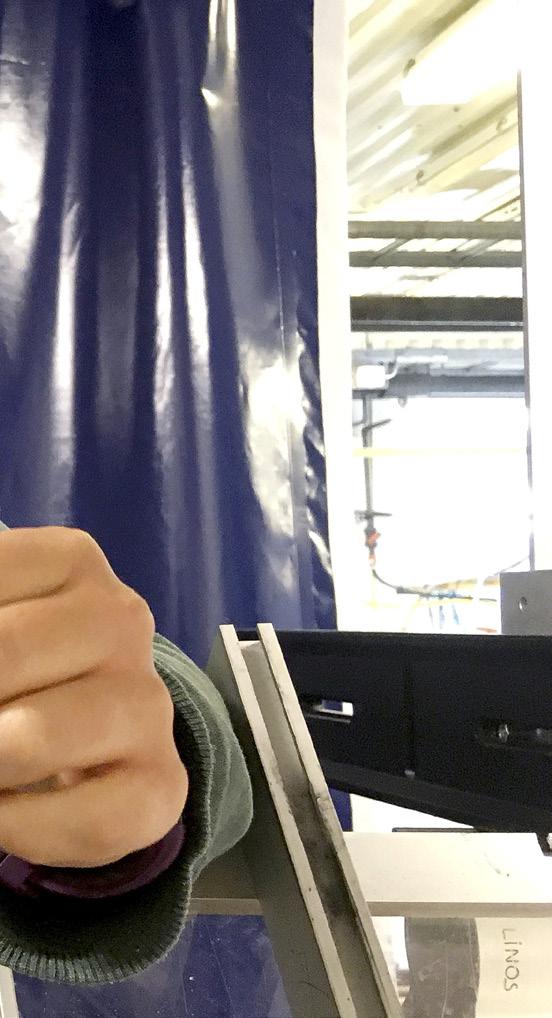
3 minute read
Counting on snails
The spiral shapes of sea snails have fascinated Jenny Larsson ever since childhood, growing up on Orust. Now she can call herself a sea snail shell mathematician after defending her thesis on how the spirals can be calculated logarithmically.
The sea snail Jenny Larsson researched is called the rough periwinkle Littorina saxatilis, and is found almost everywhere in the Atlantic but also along the entire west coast. The snail is interesting for evolutionary biologists because it is found in two ecotypes, and has adapted to different environments: a slightly smaller one that lives on unprotected beaches and hides in rock crevices when the waves wash in, and a slightly larger one with a thick shell that lives on pebble beaches among seaweed and crabs. But in areas where rocks meet the beach, there are also several intermediate forms. – What biologists are interested in is whether the snails are developing into different species, and what role heredity and environment play in that process, says Jenny Larsson.
Advertisement
To investigate how the snails differ, she has developed a mathematical model that can describe how tightly the shells’ spirals coil and how the snails grow.
– I have also created a programme where I, based on 2D photos, can construct 3D shapes of the shells and then investigate their hydrodynamic properties, i.e. the power of the wave forces that the different shapes are subjected to at different flow rates and angles. Mathematically, variation in a few parameters is sufficient to explain the diversity in shell shapes that we see in nature. The method can also be easily modified and used to investigate other snail species.
It was Jenny Larsson’s overwhelming interest in shapes and geometry that resulted in her studying mathematics. – I obtained both my bachelor’s and master’s degrees from the University of Gothenburg. Then, when I wanted to continue with doctoral studies, I heard about a collaboration on sea snails between the University


of Gothenburg and the University of Sheffield, which seemed interesting. I am formally enrolled at the University of Sheffield, but much of my research has been conducted in Sweden. Among other things, I have conducted tests in the flume tank at Tjärnö Marine Laboratory, where I measured both real sea snails and enlarged 3D plastic models.
The research involves not only a collaboration between different universities but also between mathematics and marine biology. One of Jenny Larsson’s supervisors, Torbjörn Lundh, is based at the Department of Mathematical Sciences at the University of Gothenburg and Chalmers, while the other, Roger Butlin, works at the department of Marine Sciences at the University of Gothenburg and the University of Sheffield.
There are some differences between being a doctoral student in Sweden and in the United Kingdom, even if they are not that significant, says Jenny Larsson. – In England, the educational programme has slightly fewer courses and the doctoral students are seen more as students than as colleagues. Doctoral theses in my subject are more commonly written as monographs in comparison to what we are used to here, but I have still done a compilation thesis. Nor are relatives and friends invited when you are defending your thesis, instead it is a closed discussion between the doctoral student and the examiners. Brexit has not affected my situation too much during my actual doctoral studies, even though it is a constant topic of discussion, and definitely affects future opportunities. The pandemic has meant that my thesis has taken longer than planned, partly because you do not have the same opportunities for spontaneous discussions when working from home, but also because the start of one experiment was delayed. Now, I hope to be able to continue my research, preferably in Sweden, but I am open to other possibilities.
The large and thick shell, the smaller and thinner shell, and in the middle, an intermediate shape.
Text: Eva Lundgren Photo: Susanne Liljenström
Facts
Jenny Larsson Defended her doctoral thesis: Understanding the evolution of shell shape in snails, on March 31. Hobbies: Astronomy, exercise, baking, previously competed in synchronised figure skating at an elite level, finishing in the top 10 in the World Championships on several occasions.

Jenny Larsson discusses her experiments at Tjärnö marine laboratory.










